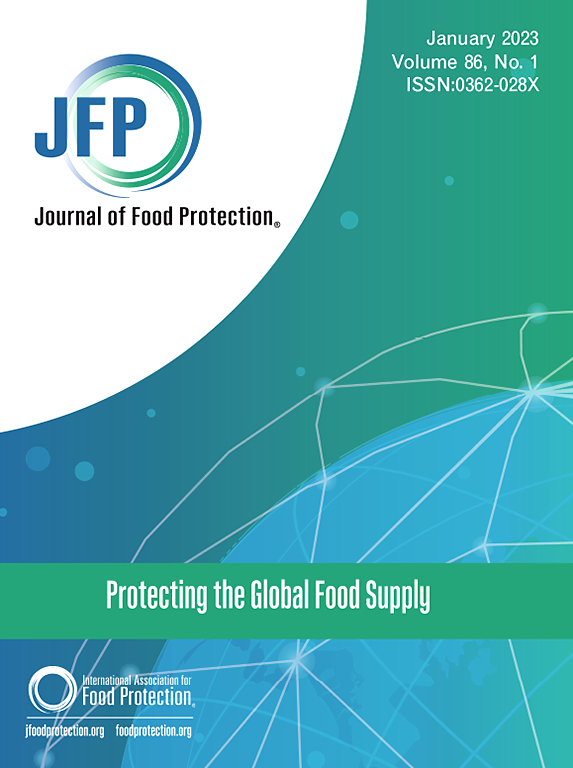Impact of Material Type and Relative Humidity on the Survival of Escherichia coli, Listeria monocytogenes, and Salmonella enterica on Harvest Bags
IF 2.1
4区 农林科学
Q3 BIOTECHNOLOGY & APPLIED MICROBIOLOGY
引用次数: 0
Abstract
Harvest bags, if not properly cleaned and sanitized, can serve as sources of microbial contamination, making it vital to understand pathogen survival on these surfaces to inform sanitation best practices. The study objective was to assess the survival of generic Escherichia coli, Listeria monocytogenes, and Salmonella enterica on harvest bag materials: 100% canvas, nylon, and Cordura. Coupons from each material were inoculated with rifampicin-resistant strains of E. coli or rifampicin-resistant 5-strain cocktails of L. monocytogenes or S. enterica at ca. 7.3 ± 0.1 log CFU/coupon. Coupons were air-dried until the inoculum was visibly dry and held at 22°C under different relative humidity (RH) conditions: 30 or 80% RH for E. coli (90 d) and 55% RH for L. monocytogenes and S. enterica (21 d). E. coli concentration was enumerated at 12 time-points: 0, 1.5, 4, and 8 h, and 1, 2, 3, 7, 14, 30, 60, and 90 d post-inoculation. L. monocytogenes and S. enterica levels were enumerated at 10 time-points: 0, 1, 4, and 8 h, and 1, 2, 3, 7, 14, and 21 d. Coupons were massaged for 60 s with 20 mL of 0.1% peptone and plated in duplicate on selective and non-selective media in triplicate experiments with triplicate replicates (n = 9). Models were fitted to describe bacterial die-off in log CFU/coupon over time. E. coli exhibited a triphasic die-off with a faster rate of die-off on nylon surfaces. S. enterica demonstrated greater die-off on Cordura compared to canvas, and L. monocytogenes followed a biphasic die-off, with no significant difference in survival across the materials. Findings indicate E. coli survival was influenced by RH, time, and material, with the fastest die-off on nylon materials. S. enterica die-off was influenced by material and time with a faster die-off on Cordura. L. monocytogenes exhibited similar die-off on canvas and Cordura. Sanitization of harvest bags is recommended to reduce contamination risks as pathogen survival can be influenced by bag material and environmental conditions.
材料类型和相对湿度对收获袋上大肠杆菌、单核增生李斯特菌和肠炎沙门氏菌存活的影响。
收获袋如果没有得到适当的清洁和消毒,可能成为微生物污染的来源,因此了解病原体在这些表面上的生存情况,为最佳卫生做法提供信息至关重要。目的是评估通用大肠杆菌、单核增生李斯特菌和肠炎沙门氏菌在收获袋材料上的存活率:100%帆布、尼龙和Cordura。每种材料的接种券分别接种耐利福平大肠杆菌菌株或耐利福平单增乳杆菌或肠链球菌的5株鸡尾酒,接种量为7.3±0.1 log CFU/次。在不同的相对湿度(RH)下,在22°C下风干,直至接种物明显干燥:大肠杆菌为30或80% RH (90d),单核增生乳杆菌和肠链球菌为55% RH (21d)。分别在接种后0、1.5、4、8 h和1、2、3、7、14、30、60、90 d 12个时间点检测大肠杆菌浓度。分别在0、1、4、8 h和1、2、3、7、14、21 d的10个时间点检测单增李斯特菌和肠链球菌的水平。用20 mL 0.1%蛋白胨按摩60秒,在选择性和非选择性培养基上进行三次重复实验(n=9)。拟合模型来描述log CFU/coupon随时间的细菌死亡。大肠杆菌表现出三相死亡,在尼龙表面的死亡速度更快。与帆布相比,Cordura上的肠球菌表现出更大的死亡,单核增生乳杆菌表现出双相死亡,不同材料的存活率没有显著差异。结果表明,大肠杆菌的存活受RH、时间和材料的影响,其中尼龙材料的死亡速度最快。肠球菌的死亡受物质和时间的影响,在Cordura上死亡更快。单增李氏菌在帆布和Cordura上表现出相似的死亡。建议对收获袋进行卫生处理,以减少污染风险,因为袋子的材料和环境条件会影响病原体的存活。
本文章由计算机程序翻译,如有差异,请以英文原文为准。
求助全文
约1分钟内获得全文
求助全文
来源期刊

Journal of food protection
工程技术-生物工程与应用微生物
CiteScore
4.20
自引率
5.00%
发文量
296
审稿时长
2.5 months
期刊介绍:
The Journal of Food Protection® (JFP) is an international, monthly scientific journal in the English language published by the International Association for Food Protection (IAFP). JFP publishes research and review articles on all aspects of food protection and safety. Major emphases of JFP are placed on studies dealing with:
Tracking, detecting (including traditional, molecular, and real-time), inactivating, and controlling food-related hazards, including microorganisms (including antibiotic resistance), microbial (mycotoxins, seafood toxins) and non-microbial toxins (heavy metals, pesticides, veterinary drug residues, migrants from food packaging, and processing contaminants), allergens and pests (insects, rodents) in human food, pet food and animal feed throughout the food chain;
Microbiological food quality and traditional/novel methods to assay microbiological food quality;
Prevention of food-related hazards and food spoilage through food preservatives and thermal/non-thermal processes, including process validation;
Food fermentations and food-related probiotics;
Safe food handling practices during pre-harvest, harvest, post-harvest, distribution and consumption, including food safety education for retailers, foodservice, and consumers;
Risk assessments for food-related hazards;
Economic impact of food-related hazards, foodborne illness, food loss, food spoilage, and adulterated foods;
Food fraud, food authentication, food defense, and foodborne disease outbreak investigations.
 求助内容:
求助内容: 应助结果提醒方式:
应助结果提醒方式:


